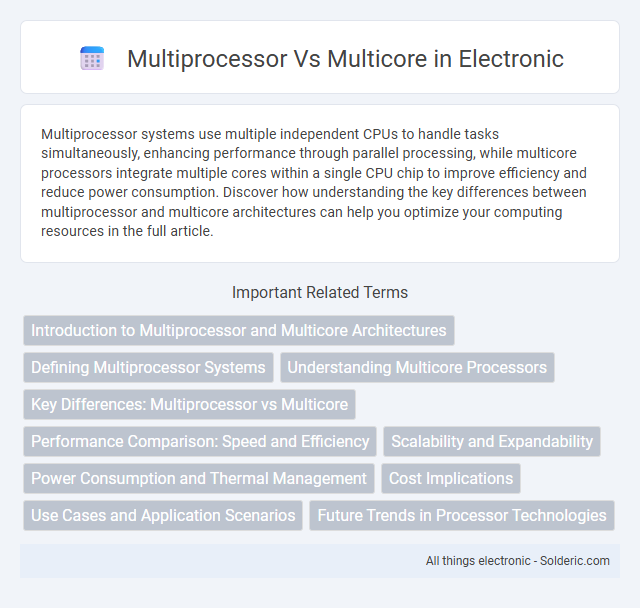Multiprocessor systems use multiple independent CPUs to handle tasks simultaneously, enhancing performance through parallel processing, while multicore processors integrate multiple cores within a single CPU chip to improve efficiency and reduce power consumption. Discover how understanding the key differences between multiprocessor and multicore architectures can help you optimize your computing resources in the full article.
Comparison Table
| Feature | Multiprocessor | Multicore |
|---|---|---|
| Definition | System with multiple separate processors (CPUs) | Single processor with multiple cores integrated on one chip |
| Architecture | Multiple CPUs on different chips | Multiple cores within one CPU chip |
| Communication | Inter-processor communication via buses or interconnects | Shares cache and bus on-chip for faster core communication |
| Power Consumption | Higher power due to multiple discrete CPUs | Lower power consumption per core due to integration |
| Cost | Generally higher due to multiple processor units | More cost-effective with integrated cores |
| Performance | Better at handling parallel tasks across CPUs | Efficient multi-threading within CPU cores |
| Scalability | Limited by motherboard and bus architecture | Scales within the CPU's chip design limits |
| Use Cases | High-performance servers, supercomputers | Consumer laptops, desktops, mobile devices |
Introduction to Multiprocessor and Multicore Architectures
Multiprocessor architectures consist of multiple independent processors working in parallel, sharing memory and system resources to enhance computational speed and reliability. Multicore architectures integrate multiple processing cores within a single physical processor chip, improving performance and energy efficiency by enabling concurrent execution of multiple threads. Both architectures aim to increase processing power but differ in design, scalability, and application in modern computing systems.
Defining Multiprocessor Systems
Multiprocessor systems consist of two or more independent CPUs that work simultaneously, enhancing computing power and reliability through parallel processing. Unlike multicore processors, where multiple cores exist on a single chip, multiprocessor systems use separate processing units that can share memory or operate independently. Your choice between these architectures depends on the workload complexity and scalability requirements of your applications.
Understanding Multicore Processors
Multicore processors integrate two or more independent cores on a single chip, enhancing parallel processing and energy efficiency compared to traditional multiprocessor systems that use multiple separate CPUs. Each core in a multicore processor handles separate tasks simultaneously, improving overall system performance and reducing latency for complex applications. Multicore technology enables better resource sharing, lower power consumption, and compact design, making it ideal for modern computing demands.
Key Differences: Multiprocessor vs Multicore
Multiprocessor systems feature two or more separate CPUs within a single computer, each with its own memory and bus, allowing parallel processing of multiple tasks simultaneously. Multicore processors integrate multiple processing cores on a single chip, sharing memory and cache to enhance performance and energy efficiency in handling concurrent threads. The key difference lies in architecture: multiprocessors use discrete CPUs, while multicore processors rely on multiple cores within one CPU chip, impacting scalability, cost, and power consumption.
Performance Comparison: Speed and Efficiency
Multiprocessor systems often deliver superior speed by distributing tasks across multiple CPUs, enhancing parallel processing capabilities compared to multicore processors. Multicore processors improve energy efficiency and reduce latency by integrating multiple cores within a single chip, optimizing performance for individual and multi-threaded applications. Your choice between the two depends on workload demands, with multiprocessors excelling in high-throughput environments and multicore processors offering balanced speed and efficiency for everyday computing.
Scalability and Expandability
Multiprocessor systems offer superior scalability by allowing multiple independent CPUs to be added, enhancing overall processing power and facilitating workload distribution across distinct processing units. Multicore processors integrate multiple cores within a single chip, providing improved energy efficiency and communication latency, but face physical limitations when scaling beyond a certain number of cores. Expandability in multiprocessor configurations is typically more flexible, accommodating heterogeneous processors and easier upgrades, whereas multicore designs require comprehensive hardware redesigns to increase core counts significantly.
Power Consumption and Thermal Management
Multiprocessor systems typically consume more power and generate higher heat due to multiple independent CPUs operating simultaneously, requiring advanced thermal management solutions like enhanced cooling systems and heat sinks. Multicore processors integrate multiple cores within a single chip, enabling more efficient power usage and lower thermal output by sharing resources and optimizing workload distribution. Effective thermal management in multicore designs often involves dynamic voltage and frequency scaling (DVFS) to balance performance with heat dissipation.
Cost Implications
Multiprocessor systems generally involve higher costs due to the need for multiple separate CPUs, additional motherboard support, and increased power consumption, whereas multicore processors integrate multiple cores into a single chip, reducing manufacturing and operational expenses. Your choice between multiprocessor and multicore configurations significantly impacts budget planning, as multicore solutions often deliver better cost-efficiency for parallel processing tasks. Evaluating cost implications includes considering not only hardware expenses but also cooling requirements and system scaling potential.
Use Cases and Application Scenarios
Multiprocessor systems, featuring multiple CPUs, excel in high-performance computing environments such as data centers and scientific simulations where parallel processing of independent tasks is critical. Multicore processors integrate several cores within a single CPU, making them ideal for everyday computing, gaming, and mobile devices due to their efficiency and lower power consumption. Your choice depends on workload requirements: multiprocessor setups suit heavy multitasking and server applications, while multicore designs are optimized for balanced performance and energy efficiency in consumer electronics.
Future Trends in Processor Technologies
Future trends in processor technologies emphasize the integration of multicore architectures within multiprocessor systems to enhance computing power and energy efficiency. Advances in chip manufacturing processes enable higher core densities and improved inter-core communication, accelerating parallel processing capabilities. Your computing performance will significantly benefit from heterogeneous cores combining general-purpose and specialized processors to optimize workloads in emerging applications like AI and edge computing.
Multiprocessor vs multicore Infographic

 solderic.com
solderic.com